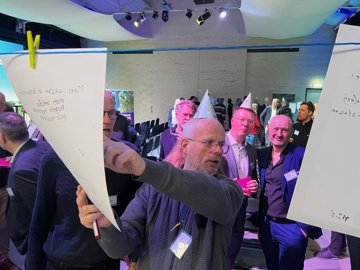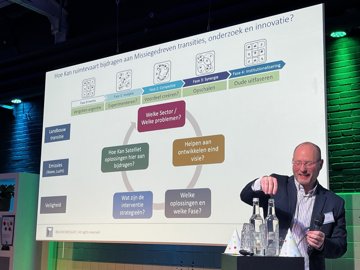Users at focus of festive meeting on satellite data applications
How can we make maximum use of valuable satellite data? That was the main question during "The party of the user" on February 28 at the Prodentfabriek in Amersfoort. It was a party with a mixed crowd, complete with hats and garlands....
Over eighty people descended on the party, which was organized by AeroVision on behalf of the NSO. Besides potential users of satellite data, there were also policy makers, knowledge workers, financiers and service providers developing satellite applications. A diverse group - and that was exactly the intention, says NSO director Harm van de Wetering:
'Space is cool. We read about it in newspapers, we see it on TV. But what you don't hear so often is how great the added value of space is for everyone on earth. For the transportation sector, dike monitoring, safety, water management, in the fire department and much more. All those end users of space are the focus today.'
Chain of specialists

Participants match demand and supply.
They were given party hats, the potential end users. On a sheet of paper they wrote down their question or need. They hung those sheets on a line, like flags on a garland. Each with their own question, the end users then spoke with other invitees: people who might be able to do something for them. Was there a match? Then the helper also put on a party hat.
`High resolution thermal imaging' was written on one of the flags. `Satellite data as evidence of violations of human rights and the law of war' on another. Someone sought `images of water balance on agricultural plots.' And yet another "reliable measurements of deformation of bridges and overpasses. Thus the versatile garlands showed dozens of possible applications of satellite data.
Making such an application is not easy. During the day, it became clear that satellite applications are complex products that require a whole chain of specialists to work on. You need instrument builders, scientists, engineers, data analysts and companies that process and enrich raw data. It is important that all these links in the chain work together. Fortunately, I also see them all here in the room," Van de Wetering said.
Ask user questions
'Don't go telling me what problem I have and how you can solve it for me,' Robbert Heinicke of the Netherlands Institute for Public Safety told the partygoers. 'It starts with asking questions. I like to show you our world. Then you see, for example, that we have to monitor nine hundred square kilometers of the Veluwe. And yes, if that can be done with the help of satellites, then we are greatly helped.'
Heinicke had no trouble formulating his "user need". That's different sometimes, too. Many end users do not know exactly what they are looking for or how satellite data can help them. It is important for the space sector to ask questions first, Van de Wetering emphasizes: 'Sometimes we are driven by what is technologically possible that we do not investigate what the end user wants from us. A step in the right direction are the six user needs studies conducted by the NSO to get a better picture of society's demands.
Low-hanging fruit
Start at the user was an important conclusion of the meeting. 
How can space contribute to solving societal challenges?
Another has to do with "Mission 4" of the Long-Term Space Agenda for the Netherlands: Satellite data are a strategic tool in solving societal challenges. How do you proceed? Are you going to invent a completely new satellite together? Or do you look at what is currently up in space and try to take advantage of it starting today?
'What struck me most was the call to look at "low-hanging fruit," observes Coco Antonissen, applications program manager at the NSO. 'It costs many tens, sometimes hundreds of millions of euros to build a satellite. Perhaps we should then invest a few extra million to really make maximum use of the data such a satellite produces. Because that is exactly where the biggest gains can be made.'